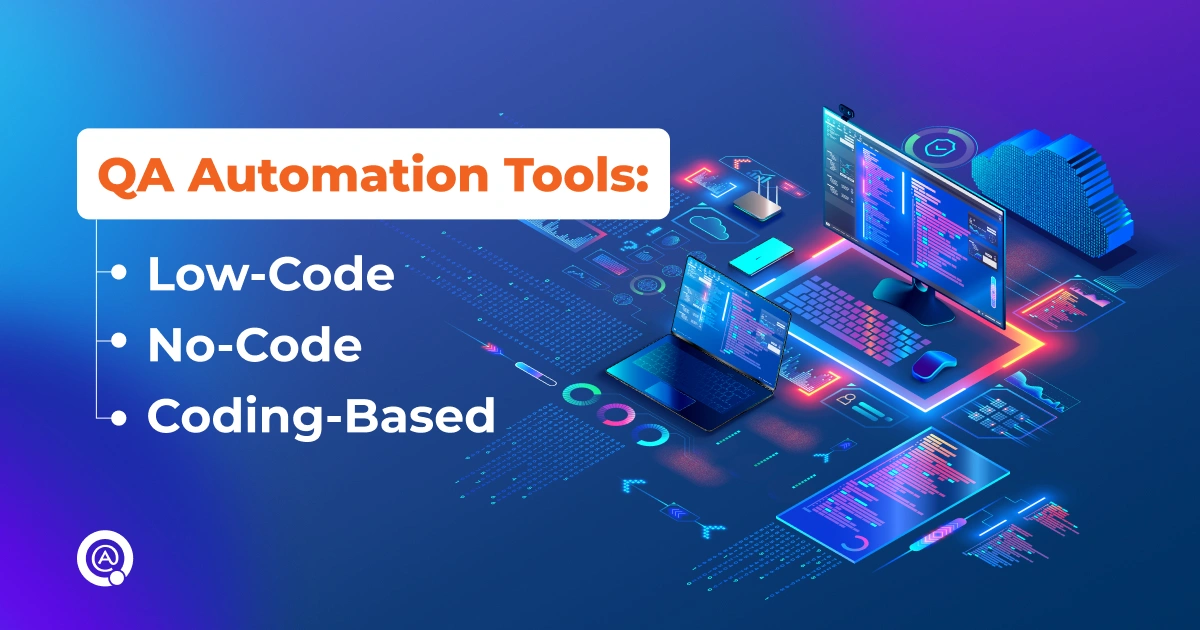- QATestLab Blog >
- QA Basics >
- Testing Tools >
- Selenium >
- QA Automation Tools: Low-Code, No-Code, or Coding-Based?
QA Automation Tools: Low-Code, No-Code, or Coding-Based?

Streamlining software testing is essential for delivering high-quality products quickly. Automated testing offers a powerful solution, but selecting the optimal approach is critical. This guide breaks down the options, comparing no-code/low-code solutions for rapid implementation with coding-based frameworks for complex projects. We’ll also provide a comprehensive list of QA automation tools to help you make the best choice for your needs.
Two Paths of QA Automation
Testing solutions for quality assurance generally fall into two categories:
- No-code/Low-Code tools allow teams to create and execute automated tests with little to no programming knowledge. They are ideal for businesses looking for quick implementation and ease of use.
- Coding-based tools require programming expertise but offer greater flexibility, control, and customization, making them the best for scalable and sophisticated verification solutions.
When to Choose No-Code/Low-Code Tools
Script-free validation platforms are gaining popularity due to their intuitive and user-friendly design. Below is the list of popular no-code/low-code tools that facilitate the creation and execution of automated tests with minimal coding effort.
Why Businesses Prefer No-Code/Low-Code Solutions
Codeless platforms make test automation accessible, allowing users to create and test scenarios with minimal coding knowledge. Businesses gain advantages from:
✔️ Fast test creation.
Tests can be set up in minutes instead of days.
✔️ Easy adoption.
Business analysts and manual testers can automate without extensive training.
✔️ Quick CI/CD integration.
No need for complex scripting or configurations.
While these solutions simplify test automation, they also introduce trade-offs that can affect long-term efficiency.
Key Considerations for No-Code Testing
Despite their ease of use, no-code tools have challenges that may limit their effectiveness in complex testing environments. Some key factors to consider include:
- High licensing costs: Many cloud-based platforms pose challenges for industries with strict on-premise compliance requirements.
- Test stability issues: UI-driven processes rely on visual elements; frequent UI changes can break recorded test cases, requiring time-consuming maintenance.
- Limited customization & scalability: No-code solutions may lack support for complex test logic, API interactions, or DevOps integrations, creating bottlenecks as testing needs grow.
- Security & data privacy risks: Many script-free platforms store data in the cloud, raising concerns for regulated industries requiring on-premise compliance solutions.
Popular Coding-Based QA Automation Tools
Many teams use coding-based testing solutions to overcome the limitations of no-code tools, offering enhanced flexibility, scalability, and seamless integration.
Below is a list of widely used code-based automation frameworks that support advanced testing needs:
Why Technical Teams Prefer Code-Based Solutions
Technical teams often require more control, scalability, and integration capabilities in their testing processes. Code-based tools offer:
✔️ Full control over test logic.
Advanced scripts can be tailored to unique scenarios.
✔️ Scalability.
Ideal for large-scale automation projects.
✔️ Seamless CI/CD integration.
Supports DevOps pipelines with advanced scripting options.
Potential Drawbacks of Coding-Based Automation
While code-based automation provides greater flexibility and scalability, it also introduces specific challenges that teams must consider:
- Higher setup and maintenance costs: These frameworks require skilled engineers, which increases setup time and maintenance efforts.
- Longer test development time: Writing automated tests requires more time than script-free systems, which can slow down agile teams.
- Flakiness and debugging overhead: UI automation scripts can be unstable across different browsers and environments, requiring ongoing debugging.
- Infrastructure and integration complexity: Unlike fully managed cloud platforms, coding-based solutions often require self-hosted infrastructure and dependency management.
Which QA Automation Tools are Right for Your Business?
With various solutions available, choosing the right one depends on your team’s expertise, project complexity, and long-term goals. Codeless platforms allow quick adoption, whereas script-driven frameworks provide greater flexibility and customization.
Use the comparative table below to find the best tool for your needs:
Final Thoughts
There is no one-size-fits-all approach to test automation. We specialize in automation solutions that fit diverse needs — whether it’s no-code/low-code tools for quick deployment and ease of use or coding-based frameworks for deep customization and scalability. Choosing the proper automation framework helps streamline workflows, reduce inefficiencies, and build a robust, scalable testing strategy.
Want to explore how our automation solutions can enhance your testing process? Contact us today to find the best fit for your needs!

Learn more from QATestLab
Related Posts:
About Article Author
view more articles






